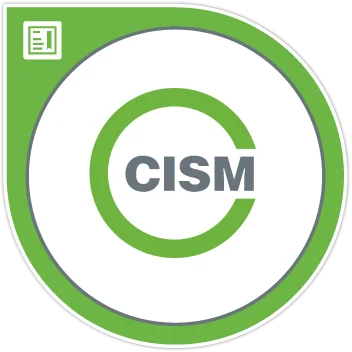Skaffa nya IT-kunskaper, bli certifierad och lyft din IT-karriär till nya höjder utan att spränga banken!
Unlimited Training - IT kurser och certifieringar gjort enkla och otroligt billiga. Få tillgång till 60+ LIVE-kurser för mindre än priset för en kurs.











course: ISACA CISM Certification
Varighet: 4 dagar
Format: Virtual or Classroom


Översikt
Skapa en väg till framgångss med ISACA CISM-certifiering, en höjdpunkt inom informationssäkerhetshantering. Få expertutbildning för CISM-provet, bli certifierad och stärk din roll som ledare för att skydda informationstillgångar. Lyft din karriär till nya höjder med en certifiering som skiljer dig åt inom cybersäkerhetsområdet. Lyft dina färdigheter, avancera i din karriär och säkra en framtid i framkant av informationssäkerhet.
 instruktörsledd utbildning
instruktörsledd utbildning Practice test
Practice test Självstudiematerial
Självstudiematerial Personlig inlärningsplan
Personlig inlärningsplan Certifieringsgaranti
Certifieringsgaranti E-post, chatt och telefonsupport
E-post, chatt och telefonsupport









Hvem henvender kurset sig til?
ISACA Certified Information Security Manager CISM certifieringen är för informationssäkerhetsproffs som är involverade i att hantera informationssäkerhetsprogram. Det syftar till att utrusta dig med de färdigheter och kunskaper som behövs för att hantera en organisations informationssäkerhetsprogram och täcker fyra domäner: Informationssäkerhetsstyrning, Riskhantering, Utveckling och hantering av informationssäkerhetsprogram och Incidenthantering för informationssäkerhet.
Kursinnehåll
Förberedelse
På Readynez tillhandahåller vi många resurser och har erfarna experter på området. Därför är vi också mycket framgångsrika med många nöjda kunder. Du kan därför tryggt gå din kurs hos oss. Det finns inga formella krav för att delta i CISM-kursen, men för att erhålla certifieringen måste du, förutom att klara ditt CISM-prov, kunna dokumentera att följande förutsättningar är på plats:
Skicka in verifierade bevis på minst fem års arbete inom informationssäkerhet, med minst tre års informationssäkerhetshanteringsarbete inom tre eller fler av de fyra domänområdena.
Arbetslivserfarenheten måste ha förvärvats inom de 10 åren före datumet för ansökan om certifiering eller inom 5 år från det datum då provet ursprungligen godkändes.
Ersättning för erfarenhet
Följande säkerhetsrelaterade certifieringar och erfarenhet av informationssystem kan användas för att utföra den angivna mängden informationssäkerhetsarbete.
Möt några av de instruktörer du möter på din kurs. De är experter, passionerade inom sina områden och dedikerade till att hjälpa de som vill lära sig, utforska och bli framgångsrika i sina karriärer.

Kevin Henry är en globalt erkänd expert som i över 20 år har bidragit till att utbilda och certifiera människor inom IT-säkerhet, inklusive CISSP, CISM, CISA och andra.
Kevin Henry is a well-known and highly respected expert instructor with Readynez.
Kevin has served for many years as an authorised instructor for (ISC)2 and he is renowned for his 20-year contribution to learners training for IT security skills- and certifications such as the CISSP, CSSLP, CISM, CISA and CCSP everywhere in the world.
Kevin is a force to be reckoned with, being an authorised instructor and training no less than 9.000 online learners monthly in the fields of information security and audit, in addition to the many students that attend his instructor-led courses with Readynez
He is also one of the most highly-rated instructors and most often he is given scores of 10/10 by his students with comments like these:
“Fantastic teaching and coaching”
Fredrik Palmquist Orange
“Most Excellent educator”
Jens Johanson Trafikverket

Friedhelm har mer än 30 års erfarenhet inom IT, säkerhet och datasekretess som senior informationssäkerhetskonsult.
Friedhelm Düsterhöft is a Senior Information Security Consultant, Auditor, Trainer and Managing Director, and has 30+ years of work experience in IT, Information Security and Data Privacy.
He has contributed to various PECB whitepapers and articles, such as ’Information Security in Banks and Financial Institutions’, ‘What Does SIEM Stand For?’, ‘Why Organizations Fail to Pass an Audit’ and “How to Integrate ISO/IEC 27032 Cybersecurity with ISMS?’.

James Rowney är en välkänd expert med över 20 års bidrag till utbildning av IT-säkerhetsfärdigheter.
James has worked on many large mission critical environments in some of the largest companies in their industries.
Understanding business requirements and drivers are essential to any strategy and design. Understanding environments are key to any application or infrastructure changes, both the immediate services they interface with and those beyond. A failure to satisfy Non Functional Requirements can not be fixed by a process.
Specialties: CISSP, CCSP, AWS Solution Architect Associate, TOGAF 9 certified 86080 member of The Association of Enterprise Architects (AEA) - 27519830. BCS Solution & Enterprise Architect Certified - AMBCS - 990529878, Linux RHCE V5 expired, RHCVA Unix, Storage, SAN, Netbackup, Clusters, Design and Delivery of Infrastructure.
FAQ
Certifieringen av Certified Information Security Manager (CISM), som erbjuds av ISACA, validerar expertis inom informationssäkerhetsstyrning, riskhantering, programutveckling och hantering. Det betyder en professionells förmåga att utforma och övervaka ett företags informationssäkerhetsprogram.
Förbered dig på CISM-framgång med vår omfattande kurs. Vår utbildning är designad av experter och säkerställer att du är redo att klara ISACA CISM-certifieringsprovet. Gå med i Readynez och utrusta dig för certifieringstriumf. Vi är specialiserade på att vägleda individer och team genom effektiva provförberedelser, vilket hjälper dig att få de färdigheter och det självförtroende som behövs för att lyckas i den utmanande CISM-certifieringsresan.
Kandidater som anmäler sig till CISM-examen måste betala en examensavgift på $575 för ISACA-medlemmar och $760 för icke-medlemmar.
Certifieringen av Certified Information Security Manager (CISM) från ISACA är högt ansedd inom informationssäkerhetsområdet och kan vara oerhört fördelaktigt för din karriär. CISM betyder expertis inom informationssäkerhetsstyrning, riskhantering, programutveckling och förvaltning – avgörande färdigheter i dagens cybersäkerhetslandskap. Att inneha denna certifiering kan förbättra din professionella trovärdighet, öppna nya karriärmöjligheter och potentiellt leda till högre intjäningspotential.
Tiden det tar att bli Certified Information Security Manager (CISM) certifierad av ISACA kan variera beroende på individuella faktorer som din tidigare erfarenhet, den tid du kan ägna dig åt att studera och din förtrogenhet med examensdomänerna. I genomsnitt kan kandidater tillbringa flera månader med att förbereda sig för CISM-provet.
ISACAs CISM-certifieringsprov är datorbaserade och administreras på auktoriserade PSI-testcenter globalt eller som fjärrkontrollerade prov.
Svårigheten att klara Certified Information Security Manager (CISM)-examen av ISACA kan variera beroende på individuella faktorer som din erfarenhet, kunskap och förberedelser. CISM-provet är känt för sin omfattande täckning av domäner för informationssäkerhetshantering, och kandidater måste visa en gedigen förståelse för styrning, riskhantering, programutveckling och incidenthantering.
Poängen beräknas på en skala från 200 till 800 poäng; för att klara provet måste du uppnå minst 450/800.
Att bibehålla din ISACA CISM-certifiering innebär att du samlar på dig 120 poäng för fortsatt professionell utbildning (CPE) under en treårsperiod, med minst 20 poäng årligen. Att följa ISACA:s yrkesetiska kod och betalning av årliga underhållsavgifter är avgörande för att säkerställa fortsatt relevans och giltighet för din certifiering.
Lönen för personer med en ISACA Certified Information Security Manager (CISM)-certifiering kan variera baserat på faktorer som erfarenhet, plats, bransch och specifika jobbroller. I genomsnitt tenderar yrkesverksamma som innehar en CISM-certifiering att tjäna konkurrenskraftiga löner, ofta över branschgenomsnittet för informationssäkerhetsroller. Lönerna kan variera från cirka 100 000 USD till långt över 150 000 USD per år, beroende på de faktorer som nämns.
Recensioner

Readynez är den bästa utbildningsleverantören jag har använt i många år. Deras kundservice är förstklassig, priserna är mycket konkurrenskraftiga och instruktörerna är utmärkta.

"Jag gick på CISM-träningen med Readynez och det här var den bästa träningen jag någonsin varit på! Instruktören gjorde det extremt enkelt att följa och gav exempel från verkligheten, och allt hände online! "
Varför betala mer?
Varför nöja sig med bara en certifieringskurs när du kan delta på ALLA certifieringskurser till ett pris som är lägre än priset för en kurs?

Ett perfekt sätt för oss att utveckla de kompetenser vi behöver för att bli framgångsrika
![]() Kasper Meyer Christensen
Kasper Meyer Christensen
Verksamheter som använder Unlimited Training sparar minst 50% på sin utbildning och certifiering - och många upp till 80%
Deltagare med Unlimited Training licens genomför i genomsnitt 2,4 kurser per år

För ett pris som är lägre än priset för en kurs

Bara billigare och mer flexibelt

Det enklaste, billigaste och mest flexibla sättet att bli certifierad på

Deltag på så många kurser du vill - inga begränsningar!

Vi betalar tillbaka om kostnaden för licensen överstiger värdet på din utbildning

Interagera 1-till-1 med 50+ erfarna instruktörer

